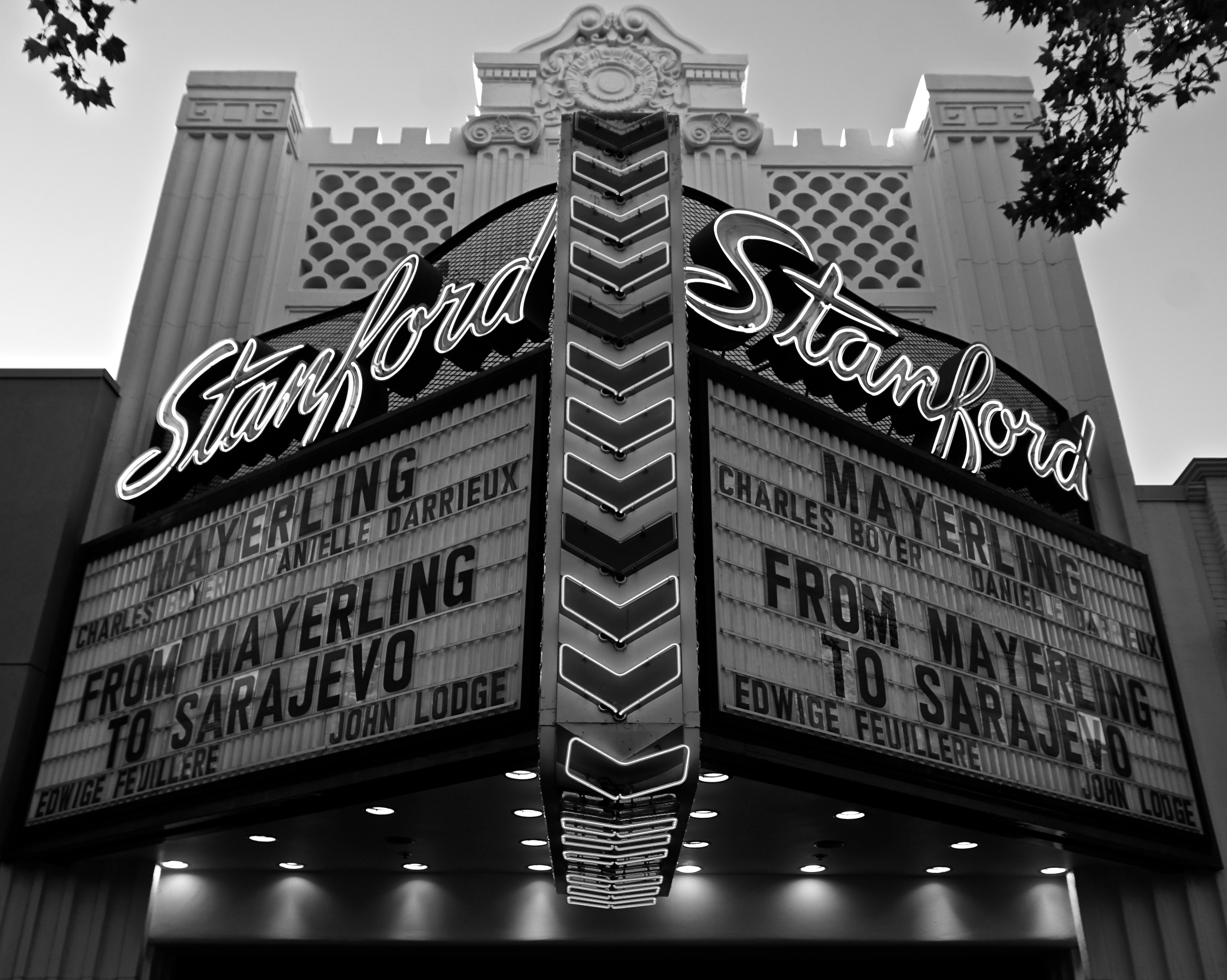Even from outside, the Stanford Theatre is a sight to behold. It is the main draw of Palo Alto’s University Avenue. Its marquee sign — a film trailer in architectural form — informs the walking-driving public of coming attractions. In a college town as atypical as chromatic Palo Alto, the marquee lends a touch of old-school class to a modernized street that gets easily overcrowded with flash-in-the-pan hipster boutiques and boba on the go.
Inside, the story continues. A grand staircase leads to a steep balcony, where a more advantageous, bird’s-eye view of the screen can be sought. In the lobby, there is a swirling mix of Assyrian colors and Greek forms. A glass candy-counter offers a variety of shockingly cheap snacks, candies, mints, popcorn, sodas — all tagged with prices ($2.50 for a large?) that seemingly haven’t changed since the 1980s. It is conscience-altering to realize that architectural masterpieces like the Stanford were made to watch flicks.
The display of art is just as visually arresting. They’re not conventional canvases or Greek statues, though — they’re movie posters. The theater is filled with original artwork from poster artists of the ’30s to the ’50s. Some were commissioned by Hollywood studios, such as a towering landscape of the Andes Mountains from Howard Hawks’ 1939 classic “Only Angels Have Wings” (“Drama as mighty as the towering Andes!!” it screams). Others were made abroad, in Japan, Italy or Spain. One prominent Japanese poster of Alfred Hitchcock’s “North by Northwest” shows Cary Grant being chased by two obstacles: a crop-duster and Japanese characters with exclamation points. Most have a look so baroque that one could spend days scrutinizing them (Bette Davis aiming a still-smoking gun at a bloodied man’s body for William Wyler’s “The Letter”). Perhaps the nuttiest ad (and a personal favorite) is a graphic of a completely nude Busby Berkeley dancer, covering her front with a white blanket, boasting a single line of text: “I’m one of the Gold Diggers of 1933!”
Going deeper into the Stanford Theatre, one comes face-to-face with the venue’s most popular draw: the house organ. The circus-like “Mighty Wurlitzer” works like any of the great, supporting players of the ’30s (Thomas Mitchell), ’40s (Agnes Moorehead) or ’50s (Thelma Ritter). It’s a part of the machine that keeps the Stanford chugging, but it’s no mere cog. Rather, the organ is perhaps the Stanford’s main-stage attraction, its personal signature.
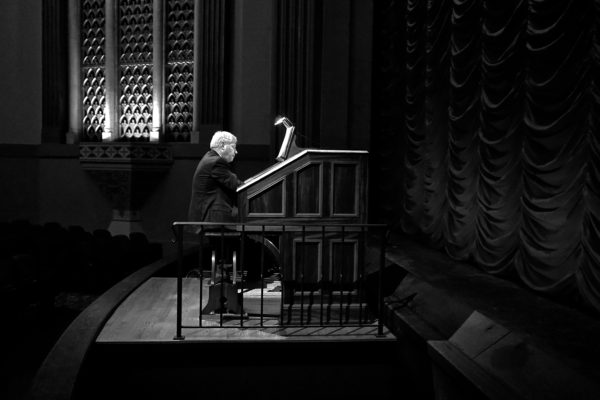
The ‘Mighty Wurlitzer’
In the bowels of the movie palace, organist Jerry Nagano sits atop his Wurlitzer for the umpteenth time. To an outsider, this massive theater organ — with its countless keys, whistles, bells and pedals — is untamable, incomprehensible. But neatly describing each part, Nagano makes reportage sound as if it were as common as breathing air.
“I always think of this as my dance partner,” he says with a slight twinkle in his eye.
Nagano has fun reminiscing about his youth — going to the movies, being immersed in the world of the (movie) theater. “I was very picky about where I would see the movies,” he says. “When ‘Star Wars’ came out, all my friends were like, ‘We want to go see “Star Wars”!’ And I said, ‘No, there’s only one theater that I want to see it in.’ I insisted that if we were going to see ‘Star Wars,’ we had to see it at Grauman’s Chinese.” After ruminating for a while, he adds, “In many cases, where I saw the film was just as important as what film I saw.”
Nagano is one of three rotating organists who play the “Mighty Wurlitzer” every night at the Stanford Theatre. Originally from Los Angeles, Nagano has worked at the Stanford since 1999. When not playing the organ, he works as a computer systems engineer at the University. “I have some of the most interesting conversations at work,” Nagano jokes. “Since I work at Stanford, I usually have people come up to me and say, ‘Gee, I knew that someone in the IT department played the organ in the theater, I just didn’t know who it was!’”
The organ predates Nagano by some years. In the early 1910s, when the theatre’s name was “The Marquee,” the organ’s prototype — a “fotoplayer machine” — was installed. A gushing Palo Alto Times article described it as “a musical instrument … equipped with orchestra bells, bass and snare drums, and traps of every description.” In June 1925, when the Marquee was rebranded, the Times used eight pages to detail every aspect of the shiny new playhouse. An entire page was dedicated to just the organ (sample headline: “Instrument is capable of untold variety of pleasing tonal effects!”). Later in the article, it is reported that “all of the tonal wealthy of the modern symphony orchestra is reproduced [in the organ]: 1st violins, cellos, basses, trumpets, flutes, clarinets, …drums, tambourines, castanets, Chinese block, tympani, orchestral bells, xylophone, cathedral chimes, marimba, and harp.” (“A grand piano is to be added in the near future.”)
When David W. Packard restored the Stanford in the late 1980s, he was determined to recapture the aural razzle-dazzle of that breathless report. So he enlisted the help of six organ experts, including Dave Banks and Cliff Luscher, to return the Wurlitzer to its 1925 glory. The organ restoration alone took two years. Packard personally computerized the console, linking it to a basement computer and to the grand, ceiling-high pipes on either side of the movie screen.
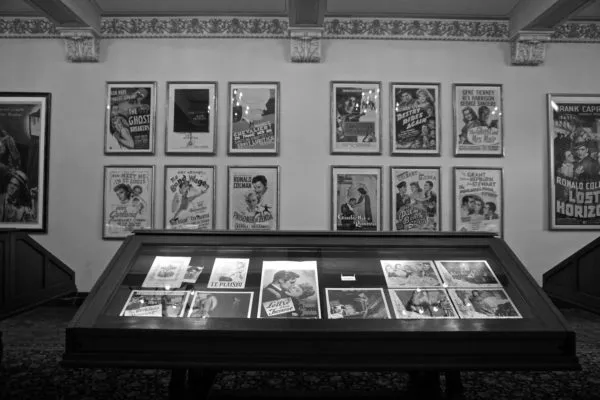
The Stanford Theatre’s past
Like the organ, the Stanford Theatre has a storied past. Under the name “The New Stanford,” it opened on June 9, 1925, with the Palo Alto Times raving, “there may be bigger theaters, but there are none better.” In the extended edition of the Times that June, pages were littered with local businesses congratulating the new Palo Alto landmark.
Its history boasts some pretty weird, unconventional moments. On April 13, 1917, a Stanford student named David Smith was arrested at the theater for loudly popping a paper bag. The next night, hundreds of Stanford students rode past the theater encouraging people not to go in, all attending a screening at the nearby Varsity Theater as a sign of protest.
Perhaps the strangest moment occurred, however, on Nov. 7, 1929. That night, 150 pajama-wearing first-years rushed the theater. Without paying, they stormed onto the balcony, occupying it to watch that night’s screening of an “Our Gang” short until they were forcibly removed by Palo Alto police. Such pre-Depression hijinx are foreign and all but lost today.
One (thankfully discontinued) tradition involved carnival-barker-style promotional deals. In 1932, the original owner of the Stanford, Allen Arkush, sold it to Fox West Coast Theatres. Later, in the postwar years, when the rise of television seemed to spell the death of cinema-going as a national pastime, Fox executives were willing to do anything to draw a crowd. They gave away $500 in gold. They held “Price is Right”-style car giveaways. They even organized a talent hunt for local Palo Alto women and children to appear as character extras in an MGM picture (“Look, Ma, Olivia’s right next to Olivia…De Havilland!”)
Soon, however, the Stanford started its slip into disuse and disinterest. The orchestra pit and organ were removed in the mid-1950s. Theater acts before and after the show were reduced to “championship baton twirling” (per the Times). By the late ’60s, the interior had accumulated so much garbage and grime that “many moviegoers flatly refused to enter the place, no matter what was showing.” In the ’70s and ’80s, the theater was caught in the midst of a game of hot potato, transferring from owner to owner, including a brief spell when it was owned by John Arrillaga. None knew what to do with it.
That is, until David W. Packard came along.
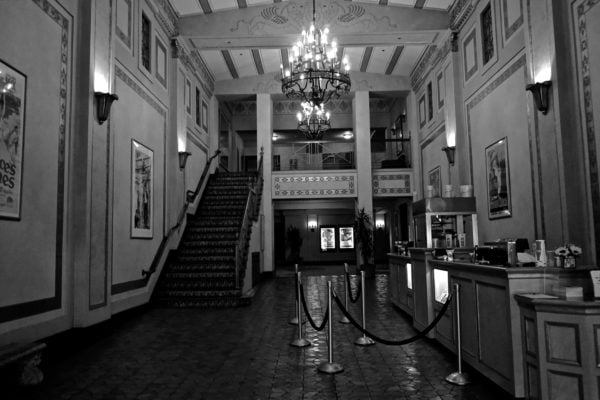
The restoration
The son of the Hewlett-Packard founder wanted to bring back life and pizzazz to the Stanford. Growing up in the area, Packard often saw motion pictures there. As an adult, though, he swore off modern movies, dismissing modern movie fare as “degraded popular culture.” He refused to set foot inside a movie theater for years. That is, until 1977, when he accepted an invitation to see “The Wizard of Oz,” a film he enjoyed as a kid.
Packard’s conversion to cinephilia reads like a classic origin story. When he watched “Wizard of Oz,” he re-exposed himself to the pleasure of movie-watching. The next night, he saw Vincente Minnelli’s “Meet Me in St. Louis” and, a night later, George Cukor’s “A Star Is Born.” All starred the ravishing Judy Garland. From there began a certifiable “Love Affair” with the movies.
In 1987, he rented out the Stanford for a two-week run of Fred Astaire films. The results were phenomenal. Packard thought that if 50 people showed up, he would deem it a success. Instead, the theater was nearly sold out on Friday night. On Tuesday night (“the night of the All-Star Game,” recalled Packard in a chat with the San Francisco Chronicle), nearly 1,250 tickets were sold.
Packard’s father was at the Tuesday night screening. As David W. Packard told the Chronicle, “[My father] couldn’t believe how many people were coming and what a good time people were having… He said, ‘David, I never would have believed this, but you’ve proved your point. If you want to do this, the foundation will pay for it.’ So we bought the theater.”
In the end, Packard’s restoration project ended up costing $6 million, or $12 million today. It was funded through the Stanford Theatre Foundation, an offshoot branch of the Packard Humanities Institute (PHI) dedicated specifically to raising public awareness of classical American cinema. The goal was to make the Stanford “a permanent center for the study and enjoyment of classic American films.”
Since about 1990, the Stanford Theatre has been managed by two players: Packard, principally, and Cyndi Mortensen, manager of the Stanford Theatre Foundation. Packard plans the programming for the theatre, and Mortensen helps him acquire film prints from distributors and studios.
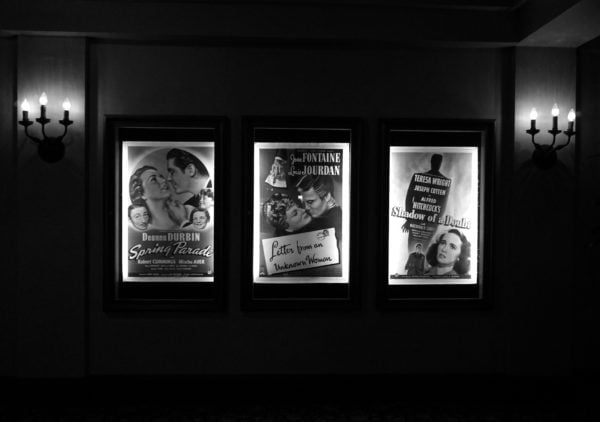
On film preservation
When I meet her, Mortensen is in the midst of hanging up Leslie Caron’s costumes from the 1958 MGM musical “Gigi” in the Stanford’s lobby. The green dress is the real deal, the actual costume from the film. She is in charge of making the Stanford run like clockwork on a daily basis and assisting Packard in maintaining public awareness of the Stanford in general.
“We must realize,” Mortensen is quick to note, “that film is not a permanent thing. It’s ephemeral. It does have a lifespan, and we must preserve it.” Packard and Mortensen always work with this goal in mind.
Indeed, part of Packard’s, Mortensen’s and the Stanford’s hard work isn’t just showing movies from the Golden Age of Hollywood. It’s also making sure these movies exist in the first place.
Film conservation is a huge legacy of the Packard Humanities Institute. Speaking on the subject of Packard and the PHI, director of the UCLA Film and Television Archive Jan-Christopher Horak says that he “can think of no one and no institution which has done more for the cause of film preservation.” Packard’s institute works closely with UCLA, the George Eastman Museum and the Library of Congress to strike new prints of both famous and obscure works of film art.
In the beginning of Hollywood’s history, film was quite literally designed to be impermanent. Before 1952, studios’ film negatives were based in nitrate film, which is highly flammable and liable to disintegrate into dust. Kept in improper conditions, nitrate can kick up in flames, as it has in the past. Major studio vault fires (a 1937 one at Fox Studios and a 1967 one at MGM) led to the loss of countless silent, early sound and animated films — works of art which could have completely changed our perception of film history.
Nitrate film must be handled with great care and stored under exacting conditions. Over a period of several years, nitrate films break down, especially if left in environments above 70 degrees Fahrenheit or humidities greater than 50 percent. It is usually stored, as in a Culpepper, Virginia location funded by Packard, in underground bunkers with temperatures far below freezing. (The Culpepper “film bunker” was originally built during the Cold War and was used to house U.S. currency.)
Nitrate film must then be transferred onto safety film, which, aside from being less flammable, ensures the delicate and damaged film negative can be used as the foundation for a restoration. Here, scratches, sound hiccups and missing frames — basically, all the superfluous errors that distract from the viewing experience — can be removed. The film can thus be restored to its original glory, viewed as it was when studios shipped prints to theaters in the ’20s through ’60s. Home video companies like the Criterion Collection & Janus Films, Masters of Cinema and Kino Lorber specialize in these kinds of restorations. Packard’s foundation helps too — and goes a step further, by electing to screen them in a movie palace like the Stanford.
Packard’s approach to his restoration work is monk-like. In a rare interview with the Los Angeles Times, Packard said, “I don’t want to be a person who goes around boasting about doing things.” At the end of the day, Packard considers himself “not a funder, [but] a colleague who has resources to contribute.” He wants the focus aimed not at himself and his efforts, but on his theater and the films themselves. Such invisible maneuvering recalls all the quiet Hollywood directors (Hawks, Minnelli, Cukor) who helmed masterful works of art while remaining hidden under a cloak of collaboration, dedication and perseverance.
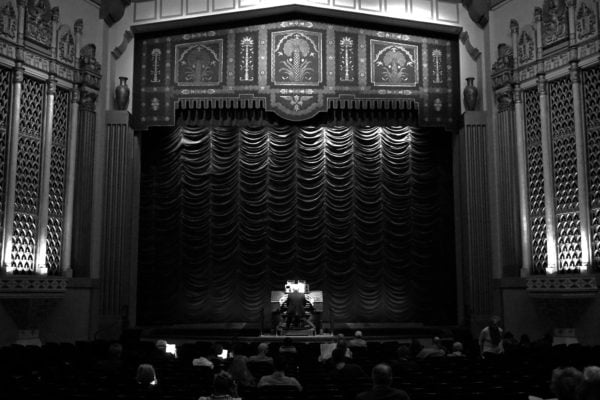
What the Stanford stands for
Above all, what makes the Stanford such a pleasure is the viewing experience. It is both personal and communal. There is the private pleasure of watching characters in the dark, feeling their feelings, embodying their spirit for a few hours. There is also the sense of community, of strangers being in this together, scurrying along the same wavelength and coming out changed.
Example: during a matinee screening of the Marx Brothers’ funniest film, Leo McCarey’s “Duck Soup” (1933), the film maintains a special layer of freshness due to the sounds of a small child’s manic giggling every five or ten seconds. The tommy-gun speed of this kid’s laughing merges with the hot-potato banter of the Marx Bros. to create a unique network of pure joy, a “buzz,” if you will.
The buzz is present in nearly all the great comedies that show here, which play to riotous roars of laughter: Hawks’ whipfast “Bringing Up Baby” and “His Girl Friday,” a naughty Ernst Lubitsch flick, the acidity and pitch-black wit of a Billy Wilder, and so on. The buzz is also present in thrillers, like when Jimmy Stewart watches a could-be killer in Hitchcock’s “Rear Window,” a movie that gains a whole new layer of meaning inside a theater, where everyone (even the people who’ve seen it before) hang breathlessly on the silent, lumbering moves of Raymond Burr, who may or may not have offed his wife. And the buzz is present when everyone breaks down in tears at a scene from a Sirk or Satyajit Ray melodrama.
All this buzzing is channeled by and through the space of the Stanford Theatre.
“What I love the most,” Mortensen says, “is the feeling I get when I’m in the auditorium, the lights go down and the curtains open. It’s a magical sensation that never goes away.”
What does the spirit of a place like the Stanford represent? It is much more than just a nifty retro exterior at a time when antique is chic.
“It’s a time machine” Mortensen says. “It gives you the experience of what it might have been like to see a movie in 1936, or ’46, or ’56.” Mortensen says the Stanford harkens back to the days of choosing your neighborhood theater. With options such as modern independent fare (the Aquarius, the Cinearts in Palo Alto Square) or blockbuster headsplitters (Century Theatres 16 in Mountain View), the movie palace offers a substantial flavor to the palate of Stanford and Palo Alto moviegoing: that of classical Hollywood.
“It’s a viewing glass” Nagano said. “It gives you the experience of watching a movie in 1936, or 1946, or 1956. “It gives you a glimpse at how times have changed, for better or for worse.”
Mortensen agrees.
“It’s a rare opportunity for people to go back in time,” she said. “Everything here is the way it was in 1925. The original posters, the 35-mm prints, the organ. There’s no other theaters that do what we do.”
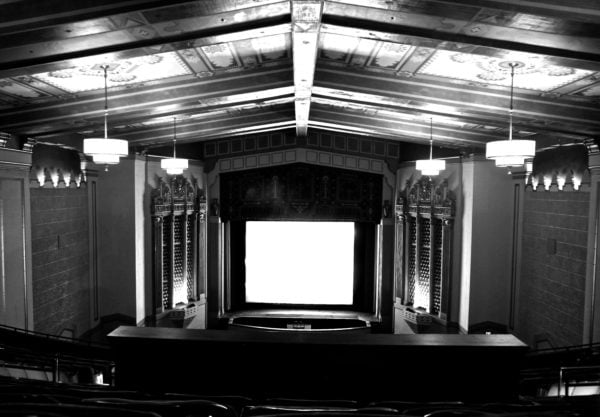
For more on why Vincente Minnelli is one of cinema’s greatest artists of emotion, contact Carlos Valladares at cvall96 ‘at’ stanford.edu, and McKenzie Lynch at mcklynch ‘at’ stanford.edu.
